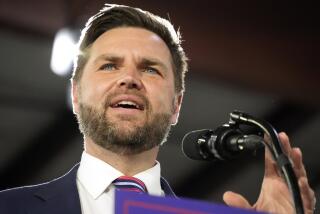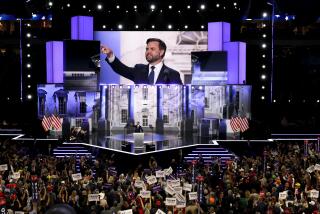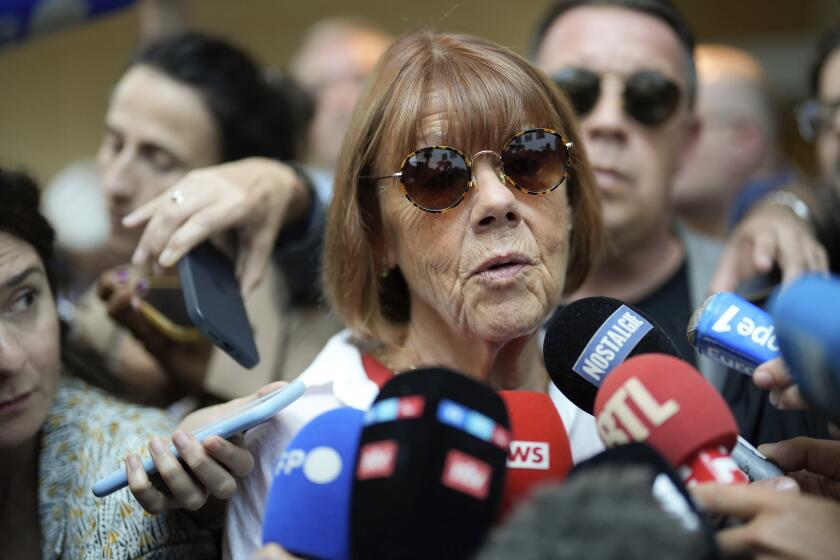The Blunt Hard-Liner at Pope John Paul’s Side
In a 1995 interview, Cardinal Joseph Ratzinger, the Catholic Church’s doctrinal czar, was asked to describe what Pope John Paul II meant when he said the third millennium would be a “springtime of the human spirit.” Ratzinger sketched the pope’s hopeful vision that, after two millenniums of division, the third millennium would be one of unity among peoples and religions, in which the entire human family would come together to build God’s kingdom.
Then Ratzinger added dryly: “At the moment, I do not yet see it approaching.”
That in a nutshell captures the difference between John Paul II and the Bavarian theologian who has been his intellectual guru since 1981 and who is back in the headlines this week with a new critique of feminism. The pope and Ratzinger -- head of what is known as the Congregation for the Doctrine of the Faith, which is, effectively, the successor to the Inquisition -- share a basically conservative stance on most issues that constitute the culture wars in the West.
Yet John Paul II plays the part of Ronald Reagan to Ratzinger’s Pat Buchanan; the pope is optimistic, cheerful, brimming with confidence, and Ratzinger is less sanguine about the movements of history. Whereas John Paul sees a church on the brink of expansion, Ratzinger believes Christianity must become smaller in order to be faithful.
This frank realism may explain why Ratzinger, who ironically started out as a liberal reformer at the Second Vatican Council in the 1960s, has been dubbed the “Panzer-Kardinal” by the German press. He is not one to apply a polite gloss, as the world saw anew on July 31 with his “Letter to the Bishops of the Catholic Church on the Collaboration of Men and Women.”
The letter pulls no punches. “Radical feminism” has promoted a climate of hostility between men and women, it argues, and has led women to deny or play down their distinctive maternal and nurturing instincts. It has also spread confusion about gender that promotes tolerance of homosexuality. The alternative vision, according to the letter, is “the collaboration of men and women,” meaning differences between the sexes should be seen as complementary rather than competitive.
Feminism is merely Ratzinger’s latest target. Since John Paul II tapped him as the church’s top theologian in 1981, he has been the driving force in several other battles:
* In the 1980s, Ratzinger cracked down on “liberation theology,” a movement in Latin America that sought to ally the Catholic Church with progressive efforts for social change. Ratzinger felt the liberationists were Marxists who wanted to introduce class struggle in the Catholic Church.
* Under Ratzinger, the Catholic Church has emphatically criticized homosexuality and gay marriage. A famous 1986 Vatican document over his signature called homosexuality a tendency toward “intrinsic moral evil.” It is still the official position of the Catholic Church.
* In the 1990s, Ratzinger disciplined a series of Catholic theologians who expressed a belief that non-Christian religions are a positive part of God’s plan.
* Ratzinger has made it much more difficult for Catholic theologians to challenge the Vatican or the bishops, insisting that even routine pronouncements enjoy a kind of infallibility.
* Most recently, a confidential memo was unearthed in which Ratzinger stated that pro-abortion Catholic politicians could be barred from receiving Holy Communion -- an explosive position that could affect Democratic presidential nominee John F. Kerry and many other American politicians.
It’s certainly possible that the Catholic Church would have taken many of these positions even without Ratzinger. Yet the intensity of the debates owes much to the man -- who, it should be said, comes across in person as meek and humble, not like the bull in a china shop that his public persona suggests.
Supporters believe he has brought clarity to a muddled world, while critics say he’s put the Catholic Church on the wrong side of progress.
What’s clear is that his effect has been felt far outside the Catholic Church, which is unusual for a Vatican official. His anti-liberation theology crusade, for instance, helped change the course of political development in Latin America, depriving progressive governments of Catholic support.
At 77, is Ratzinger’s career at twilight? Not necessarily; that’s the age at which Cardinal Angelo Roncalli was elected pope as John XXIII in 1958. Indeed, there’s a constituency in the College of Cardinals, the body that elects the pope, that would love to see the same thing happen to Ratzinger.
Yet the likelihood is that age and controversy make him a long shot.
Even so, few figures in the last 100 years of Catholic history have done more to shape their times. Ratzinger is proof that even in a secularized, post-Christian world, the Catholic Church matters. Whether he has deployed its resources for good or ill largely frames the debate facing Catholicism today.
*
John L. Allen Jr. is the Vatican correspondent for the National Catholic Reporter and author of “Cardinal Ratzinger: The Vatican’s Enforcer of the Faith” (Continuum, 2000).
More to Read
Sign up for Essential California
The most important California stories and recommendations in your inbox every morning.
You may occasionally receive promotional content from the Los Angeles Times.










